#lora mesh range
Explore tagged Tumblr posts
Text
GPIOs do LoRaMesh da Radioenge: Portas digitais
Aprenda como usar as GPIOs do módulo LoRaMesh da Radioenge
As GPIOs do LoRaMesh da Radioenge possibilita que possamos fazer aplicações de automação com um uso reduzido de hardware, dedicando apenas ao circuito de chaveamento (se necessário) e de alimentação. No total temos no LoRaMesh 8 GPIOs sendo todas configuráveis como entrada ou saída digital e duas como leitura analógica. Porém neste post vamos apenas abordar as portas digitais. Por qual motivo…
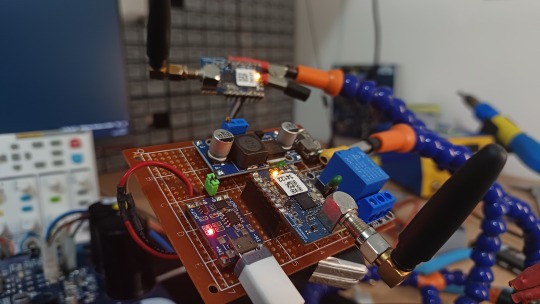
View On WordPress
#lora mesh arduino#lora mesh chat#lora mesh device#lora mesh library#lora mesh module#lora mesh network#lora mesh network raspberry pi#lora mesh protocol#lora mesh radio#lora mesh range#lora vs lorawan#loramesh#lorawan#lorawan devices#lorawan gateway#lorawan network#mesh lora
0 notes
Text
A big part of the drive for PierMesh is that I think based on Meshtastics ability to run on low power low cost boards that can be managed via a cellphone would make them helpful in disaster situations and particularly what Palestinians are going through right now. I've been trying to reach out to anyone in tech who is Palestinian/helping Palestinians who could spare some time to let me know if the efficacy of using LoRa (long range low power radio networking that can connect over kilometers) is worth trying to get some boards in that are preconfigured and encrypted. I have a lot more details I can provide and if you want to do some preliminary research yourself Meshtastics website is a good place to start:
What PierMesh would provide on top of this in its current state is multilingual support and currently I'm working on end to end encryption but even without that I think this technology could be very useful.
Thank your for your time
191 notes
·
View notes
Text
CONTROL SYSTEM
All right—if the control-grid thesis is even half-right, the problem looks like a layered weapons system aimed at civilians. Any effective response has to be layered as well. I’m going to treat it exactly the way I’d decompose an integrated air-defense network: break the kill chain, distribute the surface, and harden the targets.
1. Break the Monetary Kill-Switch
The grid’s coercive power lives inside programmable money.
Keep a cash spine alive. Insist on “cash-must-be-accepted” ordinances at city and state level, lobby merchants, and simply use paper. Every cash transaction is a privacy beacon.
Spin up community and state banks—Richard Werner-style—not as nostalgia but as literal liquidity islands outside FedNow and stable-coin rails.
Diversify into bearer assets that clear peer-to-peer: silver, gold, even commodity barter tokens.
Where digital is unavoidable, route through privacy-preserving rails (Monero, Bitcoin with CoinJoin, Fedimint, Cashu). The point is not to “get rich,” it’s to keep value flows technically unlinkable to identity.
Build local mutual-credit systems or time banks; they throttle the blackmail vector because there’s nothing to freeze.
2. Starve the Identity Graph
No identity = greatly reduced leverage.
Opt out of REAL ID whenever a legal alternative exists (passport card, military ID, tribal ID). The REAL ID Act itself can’t compel states to force you.
Attack the rule-making: public-comment campaigns, state lawsuits, and legislative nullification bills that forbid extra-statutory mandates at DMVs or airports.
Push self-sovereign identity (DID, VC) pilots wrapped inside state driver’s licenses; if DMV unions get paychecks from decentralized wallets, DHS suddenly has an interoperability headache.
Keep secondary identity arsenals—foreign passports, residence permits, legal entities. That’s not disloyal; it’s redundancy.
3. Build Parallel Comms
A grid that can’t talk to you can’t command you.
Neighborhood mesh: LoRa, goTenna, Reticulum, Wi-Fi HaLow nodes on solar micro-UPS.
Commodity satellite: used VHF sat-phones, off-the-shelf S-band dishes flashed with libre firmware.
End-to-end encryption by default (Signal, Session, Matrix + OMEMO). Assume the backbone is owned; the endpoints are where we still have leverage.
4. Data Hygiene & Obfuscation
Think of personal data as weapons-grade material—store none, move little, encrypt everything.
Use open-hardware phones (GrapheneOS, Calyx) with hardware kill-switches; carry Faraday bags.
Automatic MAC address randomization, DNS-over-HTTPS and Onion routing when you must surface.
Continual data-minimization drills: scrub old cloud accounts, sanitize metadata, tokenize e-mail aliases.
Corporate counter-intel: if you work inside an agency or contractor, mirror critical records to WORM (write once, read many) media and secure legal whistle-blower channels. The fastest way to neuter black budgets is to publish ledgers.
5. Spoof and Jam the Sensors
If the network can’t see accurately, its AI decisions degrade.
Computer-vision adversarial patches on clothing, IR LED arrays around license plates and ball-caps, gait-spoofing inserts in shoes.
“Chaff” for ALPRs: temporary magnetic overlays, anti-reflective sprays, plate flippers where legal.
Acoustic jammers for short-range lidar/police drones (ultrasonic “spotlights”).
For biometric access control, cultivate mask culture under the banner of public health—use their own policy framing.
6. Harden Physical Essentials
The grid’s leverage collapses if you aren’t begging it for food, watts, or bandwidth.
Micro-grids: rooftop solar + second-life EV packs + islanding inverters. Aim for three to seven days off-grid autonomy.
Localized food loops: hydroponics, community aquaponics, seed banks.
Rain-capture and gravity filtration so utilities can’t coerce via water service.
3-D printing and CNC co-ops for spare-part sovereignty.
7. Legal & Political Flanking
Technology buys room to maneuver; policy locks gains in.
State-level Financial Privacy Acts that ban a CBDC or stable-coin as legal tender without explicit legislative vote.
Cash-transaction threshold relief; raise reporting limits, refuse “travel rule” overreach for in-state transfers.
Freedom-of-Information hit squads: litigate for the HUD/DoD ledgers, the Epstein files, dual-citizenship disclosures, and DOGE privatization contracts. Sunlight breaks conspiracy economies.
Unionize the remaining federal workers who run mainframes and mailrooms—if they strike, FedNow queues die.
8. Culture & Narrative
No technical shield survives mass compliance.
Normalize privacy as etiquette. Teach kids OPSEC the way we teach brushing teeth.
Support fiction, film, and VR that showcase decentralized worlds; narrative inoculation is real.
Faith practices, meditation, mundane rituals—anything that trains people to pause and question commands—are cognitive jammers against automated nudging.
9. Red-Team the Grid Itself
As an engineer I can’t resist: if you’re forced to build parts of the machine, design graceful-degradation paths.
Insert open-source components; closed systems can’t hide backdoors once the community starts diffing code commits.
Modular architectures expose API chokepoints you can later rate-limit or revoke.
Maintain offline firmware signing keys, not HSM-linked to a cloud KMS. The day the system turns tyrannical, possession of the keys equals the ability to brick it.
10. Coalition Economics
Finally, remember scale. Lone-wolf tactics fail against planetary infrastructure; aligned coalitions matter.
City mayors want tax bases, not riots; propose “surveillance-free enterprise zones” in exchange for business relocation.
Small banks need deposits; feed them in return for resisting Fed integration.
Rural electric co-ops, credit unions, volunteer fire departments—those are legacy decentralized institutions already trusted by their members. Bolt new tech onto them rather than trying to mint trust from scratch.
None of this is hypothetical. Every tool I’ve listed already exists in prototypes or production. The gap is coordination, not technology.
0 notes
Text
Data Security and Precision Control: Precision Application of Smart Irrigation Using LoRa Technology and LoRaWAN Gateway
The application characteristics of LoRa modules in smart irrigation technology are mainly reflected in the following aspects:
Low Power Consumption: LoRa modules are characterized by extremely low power consumption, enabling devices to operate for extended periods on battery power. This reduces the hassle of frequent battery replacements and enhances the system's lifespan and reliability.
Anti-Interference Capability: LoRa technology has excellent anti-interference capabilities., ensuring stable communication quality even in environments with multiple radio signals.
Long-Distance Transmission: Utilizing low-frequency transmission, spread spectrum technology, and high-sensitivity receivers, LoRa modules can achieve wireless communication over distances ranging from several kilometers to over ten kilometers.
MESH Self-Organizing Network: LoRa modules can establish communication connections through self-organizing networks, eliminating the need for complex infrastructure and network wiring.
Precision Irrigation: LoRa modules offer stable and accurate data transmission, enabling real-time delivery of information such as soil moisture and weather conditions.
High Penetration: LoRa technology boasts strong signal penetration and stability, ensuring reliable signal transmission even in complex environments.
Multi-Node Support: LoRa modules support applications with multiple nodes. A single LoRa gateway can connect multiple sensor nodes, forming a complete network system for extensive, multi-point monitoring and management.
Data Security: LoRa modules provide high data security, employing encryption technology to protect data during transmission, preventing data theft or tampering, and ensuring the confidentiality and integrity of agricultural data.
Wide Coverage: LoRa technology can achieve wide coverage, typically ranging from several kilometers to over ten kilometers, without the repeaters.
Module Compatibility: LoRa modules are compatible with various types of sensors and control devices, offering a high level of system integration and facilitating seamless cooperation among different devices.

How the LoRa modules achieve precision irrigation in smart irrigation?
Remote Monitoring: Using LoRa modules, the irrigation system can achieve remote monitoring and control. Users can access real-time environmental data such as soil moisture and temperature from a distance and remotely control irrigation equipment, enabling precision irrigation.
Data Analysis: After the cloud platform receives sensor data, it analyzes and processes the information to promptly understand soil moisture conditions, providing a scientific basis for irrigation decisions.
Remote Control of Equipment: LoRa modules transmit commands to various irrigation nodes through long-distance, low-power wireless communication, controlling valve switches, irrigation times, and irrigation amounts.
Timed Irrigation: The irrigation schedule can be preset, and the LoRa module can be used to control the irrigation equipment to irrigate at the best time.
Feedback Mechanism: After irrigation is completed, the system re-monitors soil conditions and feeds the data back to the central control system.
Functions of the LoRaWAN Gateway LG1301-PF in Smart Irrigation Systems
Features of the LG1301-PF Gateway
LG1301-PF is the LoRaWAN gateway. It can work with any LoRaWAN node which comply Standard LoRaWAN protocol V1.0.
The gateway use linux platform as host.It mainly consists of concentrator ,GPS module ,WIFI and Ethernet. The GPS module send NMEA frames containing time and geographical coordinates data to the host. The GPS module also output one pulse to the sx1301 per second.
The gateway receives the RF data from nodes and sends it to the server. It also receive data from the server and transmit to the nodes. The gateway connects to the server via Ethernet or WiFi.
Support for LoRaWAN Protocol: Adapts to the LoRaWAN protocol, enabling the device to communicate with standard LoRaWAN networks for remote data transmission and management.
UART Interface: Provides a UART interface for convenient data exchange and integration with other devices or sensors.
AES128 Encryption: Uses the AES128 encryption algorithm to ensure the security and privacy of data transmission.
8-Channel Simultaneous Communication: Supports up to 8 channels of communication simultaneously
Configurable Parameters: Users can flexibly configure various parameters according to specific application needs.
Global Positioning System Support: GPS functionality enables precise positioning and tracking of the device.
Remote Transmission: Supports remote data transmission, allowing real-time data transfer and management between the device and the cloud via an internet connection.
Frequency Band Support: Covers multiple frequency bands (such as EU433M, EU868M, KR920M, AS923M, CN780M, CN470M, US915M, AS915M, etc.).
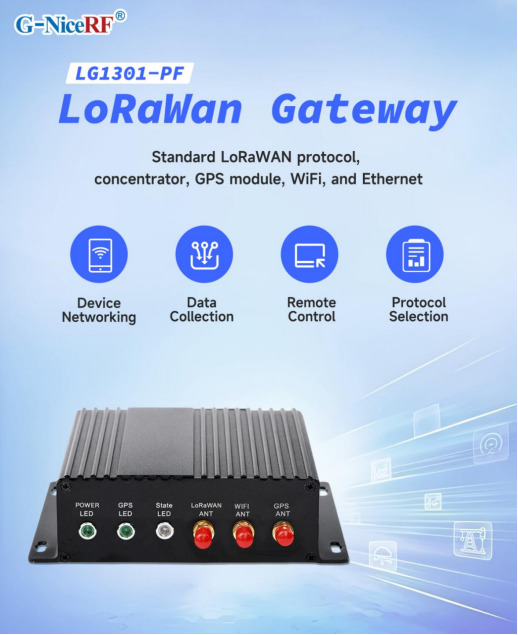
By using NiceRF LoRa gateway devices, sensor equipment in the irrigation field (such as temperature sensors, humidity sensors, light sensors, CO2 sensors, etc.) can be connected in real-time. These sensors collect data in real-time and periodically upload it to the cloud platform or local host computer via LoRa modules. This setup enables remote monitoring, fault alarms, equipment management, and provides scientific and reliable data support for adjusting irrigation strategies.
Data Monitoring Function: The sensor equipment monitors data such as air temperature, air humidity, CO2 levels, light intensity, soil moisture, and soil temperature. This data is transmitted through the LoRa gateway to the cloud platform, allowing users to analyze and process the information conveniently.
Remote Control and Adjustment: The LoRa gateway can connect to irrigation equipment, enabling remote control of the irrigation system. By sending commands from the cloud platform to the LoRa gateway, users can adjust irrigation equipment, such as remotely starting or stopping the equipment or adjusting irrigation parameters. This allows for intelligent irrigation based on feedback from soil moisture sensors, providing precise water management, reducing waste, and improving irrigation efficiency.
Anomaly Alarms and Warnings: The LoRa gateway can monitor abnormal conditions in the farmland environment and send alarm messages to users through the cloud platform. For instance, if soil moisture levels are too low or too high, the LoRa gateway can promptly issue an alert, reminding farmers to take appropriate irrigation measures.
Energy Efficiency Optimization: The gateway is designed with low power consumption features. By optimizing energy management and data transmission frequency, it effectively extends the operating time of the equipment, reduces energy costs, and enhances system sustainability.
For details, please click:https://www.nicerf.com/products/ Or click:https://nicerf.en.alibaba.com/productlist.html?spm=a2700.shop_index.88.4.1fec2b006JKUsd For consultation, please contact NiceRF (Email: [email protected]).
0 notes
Text
What is the difference between the LoRaWAN wireless module and LoRa gateway wireless transmission technology?
Many individuals find it challenging to differentiate between the LoRaWAN wireless module and LoRa gateway wireless transmission technology, as well as their applications within the realm of IoT.
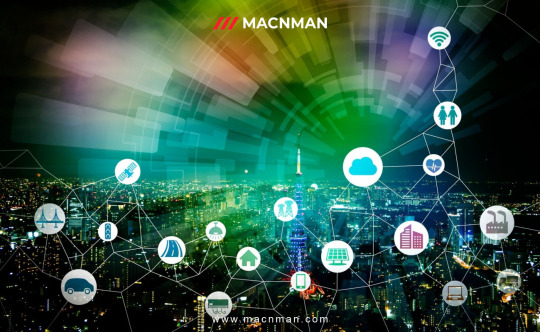
LoRaWAN specifically pertains to the networking protocol found within the MAC (Media Access Control) layer. In contrast, LoRa serves as a protocol within the physical layer. Although current LoRaWAN networking implementations utilize LoRa as the physical layer, it's worth noting that the LoRaWAN protocol also allows for the use of GFSK (Gaussian Frequency-Shift Keying) as the physical layer in specific frequency bands. From a network layering perspective, LoRaWAN can adopt various physical layer protocols, just as LoRa can serve as the physical layer for other networking technologies.
LoRa, as a technology, falls under the category of LPWAN (Low-Power Wide-Area Network) communication technologies. It represents an ultra-long-distance wireless transmission method based on spread spectrum technology, pioneered and promoted by Semtech in the United States. This approach revolutionizes the previous trade-off between transmission distance and power consumption, offering users a straightforward system capable of achieving extended range, prolonged battery life, and increased capacity. Consequently, it expands the capabilities of sensor networks. Currently, LoRa predominantly operates within free frequency bands globally, including 433/868/915MHz, among others.
On the other hand, LoRaWAN wireless communication stands as an open standard defining the communication protocol for LPWAN technology based on LoRa chips. LoRaWAN defines the Media Access Control (MAC) layer at the data link level and is overseen by the LoRa Alliance. It's crucial to distinguish between LoRa and LoRaWAN because companies like Link Labs utilize a proprietary MAC layer in conjunction with LoRa chips to create more advanced hybrid designs, such as Link Labs' Symphony Link.
LoRaWAN typically employs a star or star-to-star topology, which is generally considered superior to mesh networks due to advantages such as conserving battery power and extending communication range. In a star topology, messages are relayed to a central server through gateways, and each end node can transmit data to multiple gateways. These gateways then forward the data to the web server, where tasks like redundancy detection, security checks, and message scheduling are executed.
In summary, LoRa encompasses solely the link layer protocol, making it suitable for point-to-point (P2P) communication between nodes. In contrast, LoRaWAN includes the network layer, allowing data to be sent to any base station connected to a cloud platform. By connecting the appropriate antenna to its socket, the LoRaWAN module can operate at different frequencies, offering versatility in its applications.
0 notes
Text
Tag game! Thanks @thebloker for tagging me it makes me feel included XD
Tag 10 people to know better: @maplepastry @janeandthehivequeen @nightapproaches all I got I don't really talk to people on here
Relationship status: engaged to an incredible person named Artemis
Fav color: blue, like a really nice deep blue
Fave food:uhhhhhh, fuckin, uhhh, scalloped potatoes and ham. It's like, cubed ham, and scalloped potatoes, and a really nice creme sauce, all covered with cheese and then broiled so it'll nice and browned. Please look it up it's so good
Song stuck in head: I'd have to say I've had "Leave her Jonny" stuck in my head for about 3 years? It always comes through when I want to hum something to the point where it's almost annoying. But I still love it.
Last thing googled: diy meshtastic LoRa board. It's a really cool open source mesh network for sending encrypted messages off grid, you all should look into it it's great cause you don't need cell towers or anything.
Dream trip: never really thought about it cause it's been outta the price range. Id say down to Oklahoma to visit my friends. We helped them move down there and it's been a year and a half since we've seen them.
Last book read: oh God, it's been years since I've read fiction. Most recent book I've like, opened and read is millwrights and mechanics guide 5th edition. Very interesting stuff tbh but uh, kinda old.
Last book enjoyed:see above, it is a very good book XD
Last book hated: N/A if I didn't like a book I didn't read it so I don't remember any XD yes this applied to school, SparkNotes saved my life
Fave thing to do: usually video games. Picked up escape from tarkov 12 days ago and it's so much better than I expected. Other than that I build electronics, trying to fix a motorcycle, I wanna try making body armor from milk jugs (not crazy I promise), work at my forge, the standard adhd rotation ya know.
Most niche dislike: damn, I'm trying really hard and can't think of one. Id say like, missing one tool from a set but I feel that's pretty common. I got nothing sorry XD
Ok but this was really fun so thanks again to @thebloker for tagging me and making me feel included 🥰
2 notes
·
View notes
Text
[Media] Disaster-Radio LoRa32
Disaster-Radio LoRa32 Disaster-radio is an off-grid, solar-powered, long-range mesh network built on free, open source software and affordable hardware. Designed to be open, distributed, and decentralized. With this device you can create your own network to exchange messages! And you don't need anything but this device and sunlight :) Repository: https://github.com/sudomesh/disaster-radio Website: https://disaster.radio/ Buy online: 🛒 https://ali.ski/jXRsIy #radio #mesh
YouTubeOFF-GRID LORA Radio Mesh Text Messaging - MeshtasticHere we take a look at MESHTASTIC, An Open Source hiking, pilot, skiing and secure GPS mesh communicator using LORA Purchase here: https://ift.tt/ZFrfczN Or purchase here: https://ift.tt/lxZkMd5 Batteries: https://ift.tt/d4ayuoz https://ift.tt/9ZVMeJL Meshtastic Website https://meshtastic.org Join this channel to get access to perks: https://www.youtube.com/channel/UC9a8Z6Sp6eb2s3O79pX5Zvg/join Products used in my videos can be purchased through my Amazon storefront. US ► https://ift.tt/FRJBkmQ UK ► https://ift.tt/cTXF6Pw Support This Channel by becoming a Patreon. My Patreon ► https://ift.tt/3JBRDMa My Twitter ► https://twitter.com/techmindsyt My Amazon ► https://ift.tt/thVoPBX My PayPal ► https://ift.tt/Cw0ndx1 Merch Store ► https://ift.tt/neboF0M If you enjoyed this video please help me out by subscribing and help me get to my next Milestone of 50,000 Subscribers! #TechMinds #LORA #HamRadio
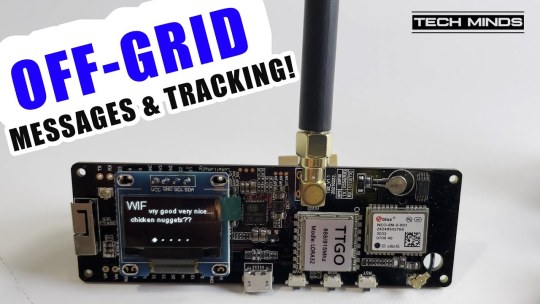
2 notes
·
View notes
Link
When the critical infrastructure that so many of us take for granted goes away, how do we organize ourselves and our communities to respond?
If recent ecological disasters have demonstrated anything, it is the inadequacy of existing models and tools to provide efficient allocation of resources, access to emergency communications, and effective coordination of human effort. Few if any solutions exist that are off-grid, affordable, reliable, easily deployed, and openly standardized.
...
disaster.radio is an off-grid, solar-powered, long-range mesh network built on free, open source software and affordable, open hardware.
Designed to be open, distributed, and decentralized, disaster.radio is currently in the prototype/development phase. To learn more about the technologies driving our development, visit the following pages:
Firmware Hardware Software User guides
disaster.radio is a collaborative project between Sudo Mesh and Secure Scuttlebutt, with additional support from the Internet Society and Institute For the Future.
Read more: https://disaster.radio/
#arduino #lora #lorawan #radio #ham #offgrid #solar #mesh #network
youtube
5 notes
·
View notes
Text
Smart BAN
Introduction to Smart Body Area Networks Body area networks, or BANs, provide benefits over broader range wireless solutions, such as 5G and LoRa. A BAN is a wireless network of sensors, actuators, and other devices installed around the human body for interpersonal or environmental interaction. Smart BANs are made up of wearable sensors communicating over a low-power mesh network to connect…

View On WordPress
0 notes
Text
What is the IoT? Everything you need to know about the Internet of Things right now
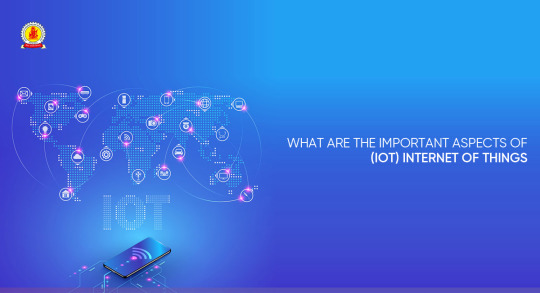
The essence of IoT is networking that student of Top Information Technology College should be followed. In other words, technologies will use in IoT with a set protocol that they will use for communications. In Communication, a protocol is basically a set of rules and guidelines for transferring data. Rules are defined for every step and process during communication between two or more computers. Networks must follow certain rules to successfully transmit data.
While working on a project, there are some requirements that must be completed like speed, range, utility, power, discoverability, etc. and a protocol can easily help them find a way to understand and solve the problem. Some of them includes the following:
1. The List
There are some most popular IoT protocols that the engineers of top engineering colleges in Jaipur should know. These are primarily wireless network protocols.
2. Bluetooth
Bluetooth is a wireless technology standard for exchanging data over some short distances ranges from fixed and mobile devices, and building personal area networks (PANs). It is invented by Dutch electrical engineer, that is, Jaap Haartsen who is working for telecom vendor Ericsson in 1994. It was originally developed as a wireless alternative to RS-232 data cables.
3. ZigBee
ZigBee is an IEEE 802.15.4-based specification for a suite of high-level communication protocols that are used by the students of Best Engineering Colleges Jaipur to create personal area networks. It includes small, low-power digital radios like medical device data collection, home automation, and other low-power low-bandwidth needs, designed for small scale projects which need wireless connection. Hence, ZigBee is a low data rate, low-power, and close proximity wireless ad hoc network.
4. Z-wave
Z-Wave is a wireless communications protocol used by the students of BTech information technology college in Jaipur primarily for home automation. It is a mesh network using low-energy radio waves to communicate from appliance to appliance which allows wireless control of residential appliances and other devices like lighting control, thermostats, security systems, windows, locks, swimming pools and garage door openers.
5. Thread
A very new IP-based IPv6 networking protocol aims at the home automation environment is Thread. It is based on 6LowPAN and also like it; it is not an IoT applications protocol like Bluetooth or ZigBee. However, it is primarily designed as a complement to Wi-Fi and recognizes that Wi-Fi is good for many consumer devices with limitations for use in a home automation setup.
6. Wi-Fi
Wi-Fi is a technology for wireless local area networking with devices according to the IEEE 802.11 standards. Wi-Fi is a trademark of the Wi-Fi Alliance which prohibits the use of the term Wi-Fi Certified to products that can successfully complete interoperability certification testing.
Devices that can use Wi-Fi technology mainly include personal computers, digital cameras, video-game consoles, smartphones and tablets, smart TVs, digital audio players and modern printers. Wi-Fi compatible devices can connect to the Internet through WLAN and a wireless access point. Such an access point has a range of about 20 meters indoors with a greater range outdoors. Hotspot coverage can be as small as a single room with walls that restricts radio waves, or as large as many square kilometers that is achieved by using multiple overlapping access points.
7. LoRaWAN
LoRaWAN is a media access control protocol mainly used for wide area networks. It is designed to enable students of private engineering colleges in Rajasthan to communicate through low-powered devices with Internet-connected applications over long-range wireless connections. LoRaWAN can be mapped to the second and third layer of the OSI model. It is implemented on top of LoRa or FSK modulation in industrial, scientific and medical (ISM) radio bands.
8. NFC
Near-field communication is a set of communication protocols that enable students of best engineering colleges in Rajasthan two electronic devices. One of them is usually a portable device like a smartphone, to establish communication by bringing them within 4cm (1.6 in) of each other.
These devices are used in contactless payment systems like to those used in credit cards and electronic ticket smartcards and enable mobile payment to replace/supplement these systems. Sometimes, this is referred to as NFC/CTLS (Contactless) or CTLS NFC. NFC is used for social networking, for sharing contacts, videos, photos, or files. NFC-enabled devices can act as electronic identity both documents and keycards. NFC offers a low-speed connection with simple setup that can be used by the students of top Engg colleges in Rajasthan to bootstrap more capable wireless connections.
9. Cellular
IoT application that requires operation over longer distances can take benefits of GSM/3G/4G cellular communication capabilities. While cellular is clearly capable of sending high quantities of data, especially for 4G with the expense and also power consumption will be too high for many applications. Also, it can ideal for sensor-based low-bandwidth-data projects that will send very low amounts of data over the Internet. A key product in this area is the SparqEE range of products including the original tiny CELLv1.0 low-cost development board and a series of shield connecting boards for use with the Raspberry Pi and Arduino platforms.
10. Sigfox
This unique approach in the world of wireless connectivity; where there is no signaling overhead, a compact and optimized protocol; and where objects are not attached to the network. Sigfox offers a software-based communications solution to the students of top engineering colleges in India where all the network and computing complexity is managed in the Cloud, rather than on the devices. All that together, it drastically reduces energy consumption and costs of connected devices.
SigFox wireless technology is based on LTN (Low Throughput Network). It is wide area network-based technology which supports low data rate communication over larger distances. It is mainly used for M2M and IoT applications which transmits only few bytes per day.
0 notes
Text
Choosing the Best IoT Data Connectivity for IoT Platform

IoT data connectivity is the most fundamental requirement of an IoT use case. However, not every IoT platformutilizes the same connectivity solutions. In order to maximize the benefit from an IoT business, one needs to have the most appropriate connectivity solution.
Selecting the Best Wireless Technology for IoT
IoT is a diverse technology. There are many IoT sensors that remain connected and transmit signals to ensure proper implementation of an IoT network. For someone trying to leverage IoT for best gains, it is important to have information about every type of IoT connectivity available.
Have a look at some IoT connectivity types and their best use scenarios:
Mobile Network Connectivity
3G, 4G and 5G are the most basic cellular network connectivity types available. When you have to cover large areas, mobile connectivity becomes a necessity. For example, connected cars can move around and still communicate if they are powered by mobile connectivity. In the future, it is expected that 5G-connectivity would power a vast network of self-driving cars. Mobile connectivity is also widely used for long-range IoT surveillance systems.
Low Powered Long Range Connectivity
When you want your IoT devices to be operational for a long time on a single battery charge, Low Powered Long Range Connectivity solutions like SigFox, LoRA, LTE-M and NB-IoT become the ideal choice. These connectivity types maintain a low data rate, which does not exert the sensors. Hence, a single battery charge lasts for a long time and the battery life is also extended. Important use cases for this type of connectivity are monitoring of environment, tracking of assets and monitoring of perishable items.
Mesh Protocols
When there is a need to supply connectivity to several sensors connected in a mesh topology, connectivity solutions like Zigbee are preferred. Although they have a short range of 100 meters or less, they are very effective in reducing the power consumption by sensors.
Wi-Fi Connectivity
When you need to connect a home network that has many IoT devices, Wi-Fi is the most suitable choice. Although it is an expensive connectivity type, it can provide greater bandwidth and low latency. Mostly, it is used for connecting home gadgets and appliances.
When it comes to IoT development, you need the most ideal connectivity solutions for maximum benefit. However, IoT is a vast field and requires greater resources. To fulfill this requirement, it is essential to have an internet of things connectivity provider that can offer versatile connectivity solutions.
Secure IoT Services excels at both connectivity and IoT billing solutions. It also offers superior tech support, so that your network remains operational at all times.
#Internet of things connectivity provider#IoT platform#IoT sensors#iot development#Iot Billing#IoT Data
0 notes
Text
Leitura analógica do LoRaMesh da Radioenge
Aprenda como usar a leitura analógica com o módulo LoRaMesh da Radioenge
A leitura analógica com o LoRaMesh possibilita com que possamos fazer um amplo sistema de sensoriamento remoto sem precisar necessariamente de microcontrolador adicional na parte do slave. Por qual motivo usar a leitura analógica do LoRaMesh da Radioenge? Uma leitura digital em muito dos casos já é mais que o suficiente para saber se algo está ou não funcionando, mas a leitura analógica do…
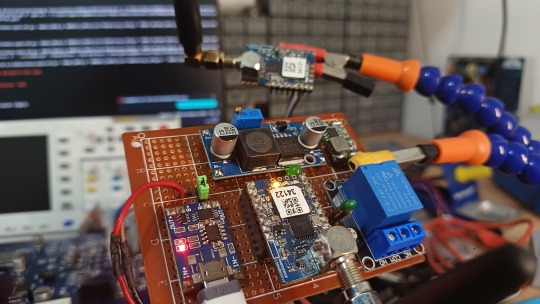
View On WordPress
#lora mesh arduino#lora mesh chat#lora mesh device#lora mesh library#lora mesh module#lora mesh network#lora mesh network raspberry pi#lora mesh protocol#lora mesh radio#lora mesh range#lora vs lorawan#loramesh#lorawan#lorawan devices#lorawan gateway#lorawan network#mesh lora
0 notes
Photo
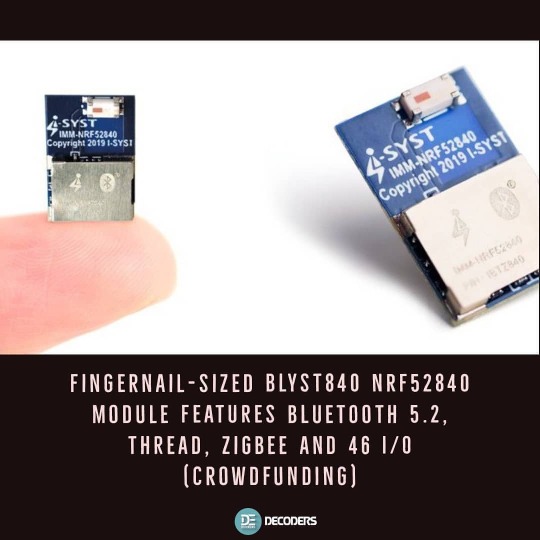
Canada based I-SYST inc has designed a tiny nRF52840 module about the size of a fingernail. BLYST840 module fully leverages the capability of Nordic Semi’s wireless microcontroller with Bluetooth 5.2, Thread, and Zigbee connectivity, and exposes 46 I/Os. BLYST840 specifications: Wireless MCU – Nordic Semiconductor nRF52840 Arm Cortex-M4F microcontroller @ 64 MHz with 1 MB flash, 256 KB RAM Connectivity Bluetooth 5.2 up to 2 Mbps, -96 dBm sensitivity for long-range; Up to 111 dB link budget; Bluetooth Mesh IEEE 802.15.4 radio support for Thread & Zigbee NFC-A Built-in ceramic antenna Output power – Adjustable from +8 dBm to -20 dBm 46 I/O pins exposed via pads around the edges of the module including QSPI/SPI/2-wire/I2S/PDM/QDEC Programmable Peripheral Interface (PPI) SPI interface @ 32 MHz Quad SPI interface @ 32 MHz EasyDMA for all digital interfaces USB 2.0 (12 Mbits) 12-bit/200K SPS ADC Security Arm TrustZone Cryptocell 310 128-bit AES/ECB/CCM/AAR co-processor Misc – Built-in 32 MHz & 32.768 MHz crystal Supply Voltage – 1.7 V to 5.5 V via battery or USB power. Dimensions – 14 x 9 x 1.6mm Certifications – FCC, IC & CE The module is programmable with MicroPython, IOsonata open-source multi-architecture multi-platform library for IoT project, as well as Nordic SDKs. You’ll find some documentation and firmware file on SourceForge. - - Source- CNX software - - ➖➖➖➖➖➖➖➖➖➖➖➖ Follow Us On: @decoders8421 Tag Your Friends 👼. Ask any query or doubt in comments. ➖➖➖➖➖➖➖➖➖➖➖➖ - #fpga #atmega #arm #nxp #embedded #iot #developmentboard #rpi #raspberrypi #arduino #arduinouno #raspberrypi3 #tinkercad #tinker #stm32 #esp32 #lorawan #lora #ai #ml #beagleboneai #raspberrypi4 #sbc #cortex #singleboard #singleboardcomputer #iot #zigbee #opencv #raspberrypicamera https://www.instagram.com/p/CBLtnTpHm-Q/?igshid=yket98i0uska
#fpga#atmega#arm#nxp#embedded#iot#developmentboard#rpi#raspberrypi#arduino#arduinouno#raspberrypi3#tinkercad#tinker#stm32#esp32#lorawan#lora#ai#ml#beagleboneai#raspberrypi4#sbc#cortex#singleboard#singleboardcomputer#zigbee#opencv#raspberrypicamera
0 notes
Text
【LoRa Spread Spectrum Modulation Technology】Ultra-High Power Long-Distance Wireless Data Transmission Radio
The LoRaP30Pro wireless data transmission radio utilizes military-grade industrial LoRa spread spectrum modulation technology, offering long communication distances, low power consumption, and fast transmission rates. It is suitable for data transmission in fields such as industrial automation, remote wireless control, industrial data acquisition, and wireless data communication.
LoRaP30Pro is rf modem and designed for 30W output power and is available in TTL/RS232/RS485 levels. It is widely used in wireless remote transmission control.
The advantages of this digital radio station are wide voltage 9-30V, ultra-long distance, dual antennas, high-end appearance.
It has built-in hardware anti-crash self-reset circuit to resist strong external interference signals. Built-in overcurrent and overvoltage reverse connection protection circuit.
LoRaP30Pro strictly uses lead-free process for production and testing, and meets RoHS and Reach standard.
LoRa Spread Spectrum Modulation Technology: LoRa spread spectrum technology enables longer communication distances. With low transmission power density, it minimizes interference with other devices. It offers high confidentiality, making it extremely unlikely to be intercepted. The technology has strong anti-interference capabilities, effectively suppressing co-channel interference and various noises. Additionally, it enhances network efficiency and eliminates interference, allowing terminals with different spread spectrum sequences to transmit simultaneously on the same frequency without causing mutual interference.
Point-to-Point and Point-to-Multipoint Transparent Transmission Modes
Point-to-Point (P2P) transmission refers to direct data communication between two devices, suitable for long-distance transmission or scenarios where monitoring points are widely dispersed.
Point-to-Multipoint (P2MP) transmission, which is slightly more complex, experiences greater signal loss during transmission compared to point-to-point (one-to-one) transmission. Therefore, it is suitable for situations where monitoring points are more concentrated, numerous, and the transmission distance is relatively short.
Functional Features of Data Transmission Radios
The data transmission radio supports a wide voltage input range (9-30V), making it suitable for various power supply environments. It features ultra-long-distance communication capabilities and a dual-antenna design, ensuring signal stability and reliability. The module has a built-in RS485 interface with an isolation circuit, providing electrostatic protection and standing wave protection, ensuring safe operation in harsh environments. It uses a custom aluminum alloy housing to enhance durability and heat dissipation performance.
The device also features a built-in hardware watchdog reset circuit that automatically restarts the device in case of anomalies, ensuring continuous and stable operation. Additionally, it has strong anti-interference capabilities, effectively resisting external strong interference signals, further enhancing the device's reliability and stability.

Multiple protection functions, such as reverse power protection, over-connection protection, and antenna surge protection, significantly increase the radio's reliability.
Operating temperature range: -40℃ to +85℃, suitable for various harsh working environments, truly an industrial-grade product.
Powerful software features include AES128 data encryption, LBT (Listen Before Talk) function, and the ability to set parameters such as node/router/node+router options in MESH mode easily and quickly via a PC interface.
Selectable hop count in MESH mode: In MESH mode, the device allows users to select the hop count for data transmission. This feature optimizes network topology according to specific needs, controls transmission delay, and ensures effective data delivery in complex multi-hop networks, thereby enhancing network flexibility and reliability.
MESH self-organizing network: Developed by NiceRF, the MESH algorithm features automatic routing, forming a network transmission system with no blind spots and no distance limitations.
Precautions for Using High-Power Wireless Data Transmission Radios
Select a suitable DC regulated power supply with strong high-frequency interference resistance, low ripple, and sufficient load capacity. It is also necessary for the power supply to have overcurrent protection, overvoltage protection, and lightning protection functions.
Do not use the radio in environments that exceed its specified characteristics, such as high temperatures, high humidity, low temperatures, strong electromagnetic fields, or dusty conditions. These environments can significantly wear down the radio, shorten the lifespan of internal components, and cause substantial signal attenuation in strong electromagnetic environments, hindering wireless signal transmission.

The ground wire of the data transmission radio should be well-connected to the ground wire of external devices (such as PCs, PLCs, etc.). Otherwise, it can easily damage the communication interface or cause signal transmission instability, leading to errors and other issues.
Antenna Selection Precautions for Data Transmission Radios
To ensure optimal communication distance for the module, follow these principles during antenna usage:
Antenna Positioning: Avoid placing the antenna close to the ground surface and keep it away from obstacles.
Magnetic Base Antennas: If using a magnetic base antenna, straighten the lead wire as much as possible, and attach the base to a metal object.
Yagi Antennas: For Yagi antennas, it is recommended to place the transmitting antenna vertically and the receiving antenna horizontally.
Note: Due to the high power output, ensure the antenna is connected before the radio starts transmitting to avoid damaging the internal power amplifier module.
Antenna Distance: The distance between the receiving and transmitting antennas should be greater than 1.5 meters.
0 notes
Text
What are the main differences between SigFox and LoRa technologies?
SigFox and LoRa are two distinct technologies used in the realm of the Internet of Things (IoT) for long-range, low-power wireless communication. Here are the key distinctions between SigFox and LoRa technologies:

Communication Protocol:
SigFox: SigFox employs a unique communication protocol and its own network infrastructure, operating on unlicensed ISM bands and utilizing a star network topology.
LoRa: LoRa (Long Range) uses chirp spread spectrum modulation and adheres to open standards, allowing for more versatile network deployments, including star-of-stars and mesh configurations.
Coverage:
SigFox: SigFox is recognized for its expansive coverage, often spanning entire regions or even countries, offering a broad geographic reach.
LoRa: LoRa's coverage is typically more adaptable and localized, with the capability to cover distances ranging from a few kilometers to over 15-20 kilometers, making it suitable for both urban and rural areas.
Data Rate:
SigFox: SigFox provides very low data rates, typically around 100 bps (bits per second), suitable for transmitting small, sporadic messages or sensor data.
LoRa: LoRa supports higher data rates, with transmission speeds ranging from 300 bps to 37.5 kbps, offering greater versatility for a wide range of IoT applications.
Power Consumption:
Both SigFox and LoRa are designed with low-power consumption in mind, but the actual power usage may vary based on specific devices and application scenarios. Generally, they are both energy-efficient technologies.
Ecosystem and Standards:
SigFox: SigFox operates its own network infrastructure, which can limit customization and scalability. It constitutes a more closed ecosystem with fewer options for adaptability.
LoRa: LoRa is built on open standards, permitting greater flexibility in constructing and adapting networks. There are multiple LoRaWAN network operators and a wider array of LoRa-compatible devices and gateways.
Licensing and Costs:
SigFox: The cost structure for SigFox services may encompass subscription fees, which can vary depending on usage and geographic location.
LoRa: LoRa networks can be deployed by various providers, and costs can vary, but there is generally more flexibility in choosing service providers and pricing models.
Scalability:
SigFox: SigFox networks are highly scalable and suitable for large-scale deployments with minimal infrastructure requirements.
LoRa: LoRa networks are also scalable and can be tailored to accommodate diverse deployment sizes, from small-scale applications to extensive IoT projects.
In summary, both SigFox and LoRa are suitable for specific IoT applications, but their differences in network architecture, data rates, and coverage make them better suited for distinct use cases. SigFox may be preferred for applications demanding extensive coverage and ultra-low power usage, while LoRa offers greater flexibility in terms of data rates and network adaptability. The choice between the two hinges on the specific needs of the IoT project.
0 notes
Text
LoRa Chipsets Market – Key Players, Size, Trends, Growth Opportunities, Analysis and Forecast To 2027
LoRa is digital wireless data communication technology useful for long range communication. LoRa is also refers to the systems that support the modulation, with use of LoRa chipsets and gateways. It is a radio modulation scheme, a way of manipulating a radio waves to encode information using a chirped, multi symbol format. Further, this allows transmission of as far as 15 km with clear line of sight and a typical range in urban area is 2 to 3 km. LoRa chipset provide much longer range for low data rate applications compared to other priced radio technologies. Furthermore, it also offers good receiver sensitivity and low bit error rate. LoRa chipset technology is ideal for low power applications and battery operated sensor such as sensor networks internet of things, smart agriculture, industrial automation, manufacturing applications, asset tracking, smart meters, smart home, M2M, and others. Moreover, it is also applicable in smart city for various application including supply chain management with asset tracking & condition monitoring, water & gas metering, land condition monitoring or animal tracking and geo fencing, smart parking, intelligent street lighting, power station monitoring, smart grids with electricity, and others.
The LoRa chipsets market is primarily driven by the increased deliveries of LoRa chipset in IoT applications including healthcare and pharmaceuticals, media and advertising, logistics & shipping, and asset tracking, and others. The smart city investment expected to trigger adoption of LoRa chipset for various application including intelligent street lighting, smart meters, asset tracking, smart home and others. The usage of LoRa technology is providing real time data for parking management, making it easier for drivers to find available parking spaces for off street and on street private and public parking management. Further, it helping to reduce carbon emissions and traffic congestion caused by drivers retracing their steps repeatedly in an effort to find available parking. Further expected to foster the global LoRa chipsets market during forecast period. Global leaders of LoRa chipsets market are focusing on offering long range, high capacity, long battery life, reduced synchronization overhead and no hops in mesh network, secured and efficient network, reduce size, continuous frequency coverage, and interference immunity products. Several technological limitations such as gateways are tied to the same server expected to hinder the growth of the global LoRa chipsets market during forecast period.
Get Sample Copy of the Report to understand the structure of the complete report (Including Full TOC, Table & Figures): https://www.transparencymarketresearch.com/sample/sample.php?flag=S&rep_id=65111
The global LoRa chipsets market has been segmented based on end use industry, and region. Based on end-use industry, the market can be segmented into healthcare and pharmaceuticals, media and advertising, agriculture, logistics & shipping, energy & utilities, asset tracking, and others. In terms of region, the global LoRa chipsets market can be segregated into North America, Europe, Asia Pacific, Middle East & Africa, and South America. North America and Europe is anticipated to contribute a significant share to the global LoRa chipsets market due to the presence of leading LoRa chipset manufacturers, for instance, Qualcomm, Intel, and Microchip Technology Inc. in this region. The market in Asia Pacific is anticipated to expand at a rapid pace owing to the expansion of application industry verticals such logistics tracking, smart city and healthcare, in emerging economies such as India and China, in this region.
Key players operating in the global LoRa chipsets market include Semtech Corporation, Microchip Technology Inc, Murata Manufacturing Co., Ltd, Hoperf, Gemtek, STMicroelectronics, Qualcomm, Huawei, Nordic, NB-IoT, Intel, ZTE, and others. These players are actively focusing on organic and inorganic growth strategies in order to gain a competitive advantage in the market. Some of the important strategies adopted by the leading players in the global market are collaborations, partnerships, agreements, and new product launches. The report provides an in-depth analysis about the strategic business activities along with the market dynamics shaping the global LoRa chipsets market over the period of study.
The report offers a comprehensive evaluation of the market. It does so via in-depth qualitative insights, historical data, and verifiable projections about market size. The projections featured in the report have been derived using proven research methodologies and assumptions. By doing so, the research report serves as a repository of analysis and information for every facet of the market, including but not limited to: Regional markets, technology, types, and applications.
Request For Covid19 Impact Analysis Across Industries And Markets – https://www.transparencymarketresearch.com/sample/sample.php?flag=covid19&rep_id=65111
The study is a source of reliable data on:
Market segments and sub-segments
Market trends and dynamics
Supply and demand
Market size
Current trends/opportunities/challenges
Competitive landscape
Technological breakthroughs
Value chain and stakeholder analysis
The regional analysis covers:
North America (U.S. and Canada)
Latin America (Mexico, Brazil, Peru, Chile, and others)
Western Europe (Germany, U.K., France, Spain, Italy, Nordic countries, Belgium, Netherlands, and Luxembourg)
Eastern Europe (Poland and Russia)
Asia Pacific (China, India, Japan, ASEAN, Australia, and New Zealand)
Middle East and Africa (GCC, Southern Africa, and North Africa)
The report has been compiled through extensive primary research (through interviews, surveys, and observations of seasoned analysts) and secondary research (which entails reputable paid sources, trade journals, and industry body databases). The report also features a complete qualitative and quantitative assessment by analyzing data gathered from industry analysts and market participants across key points in the industry’s value chain.
Customization of the Report: This report can be customized as per your needs for additional data or countries. – https://www.transparencymarketresearch.com/sample/sample.php?flag=CR&rep_id=65111
About Us
Transparency Market Research is a next-generation market intelligence provider, offering fact-based solutions to business leaders, consultants, and strategy professionals.
Our reports are single-point solutions for businesses to grow, evolve, and mature. Our real-time data collection methods along with ability to track more than one million high growth niche products are aligned with your aims. The detailed and proprietary statistical models used by our analysts offer insights for making right decision in the shortest span of time. For organizations that require specific but comprehensive information, we offer customized solutions through adhocreports. These requests are delivered with the perfect combination of right sense of fact-oriented problem solving methodologies and leveraging existing data repositories.
TMR believes that unison of solutions for clients-specific problems with right methodology of research is the key tohelp enterprises reach right decision.”
Contact
Transparency Market Research
State Tower,
90 State Street,
Suite 700,
Albany NY – 12207
United States
USA – Canada Toll Free: 866-552-3453
Email: [email protected]
Website: https://www.transparencymarketresearch.com
0 notes